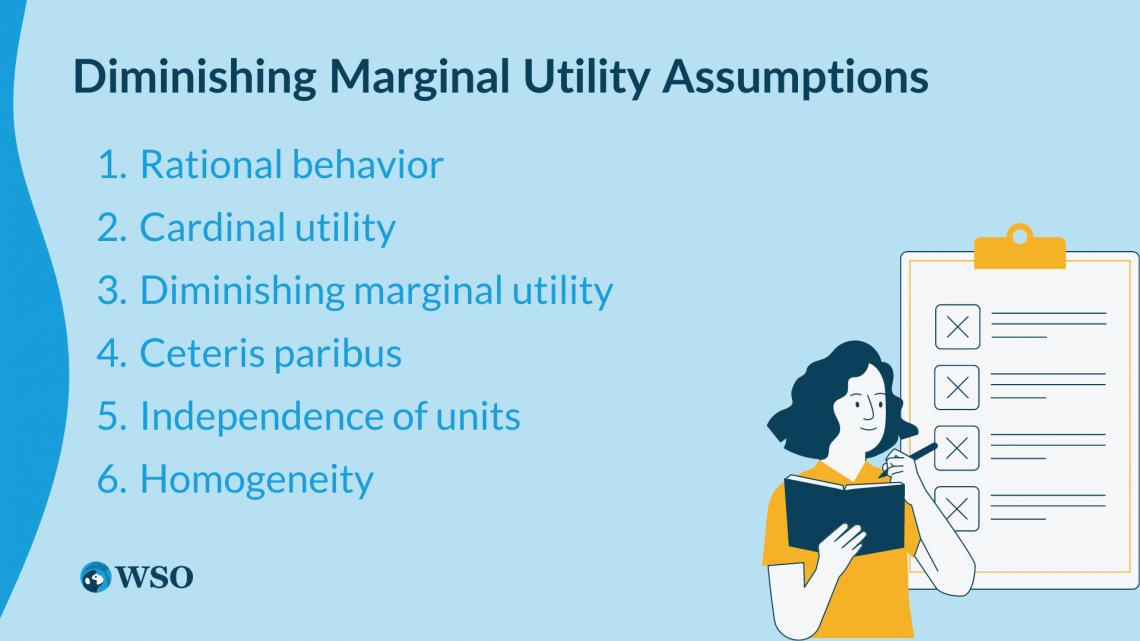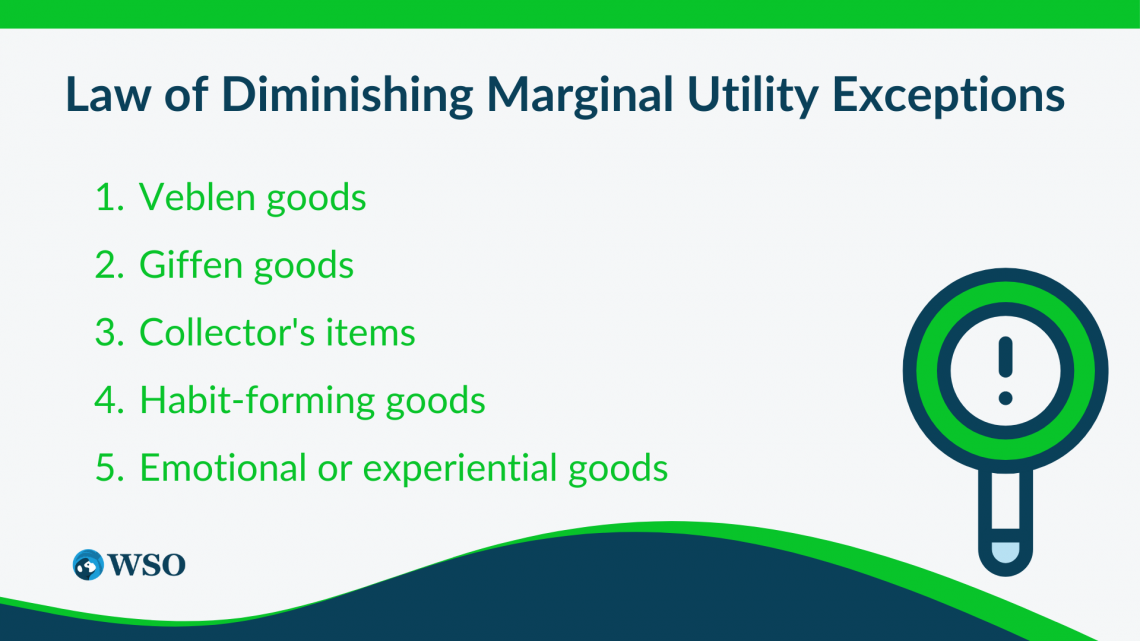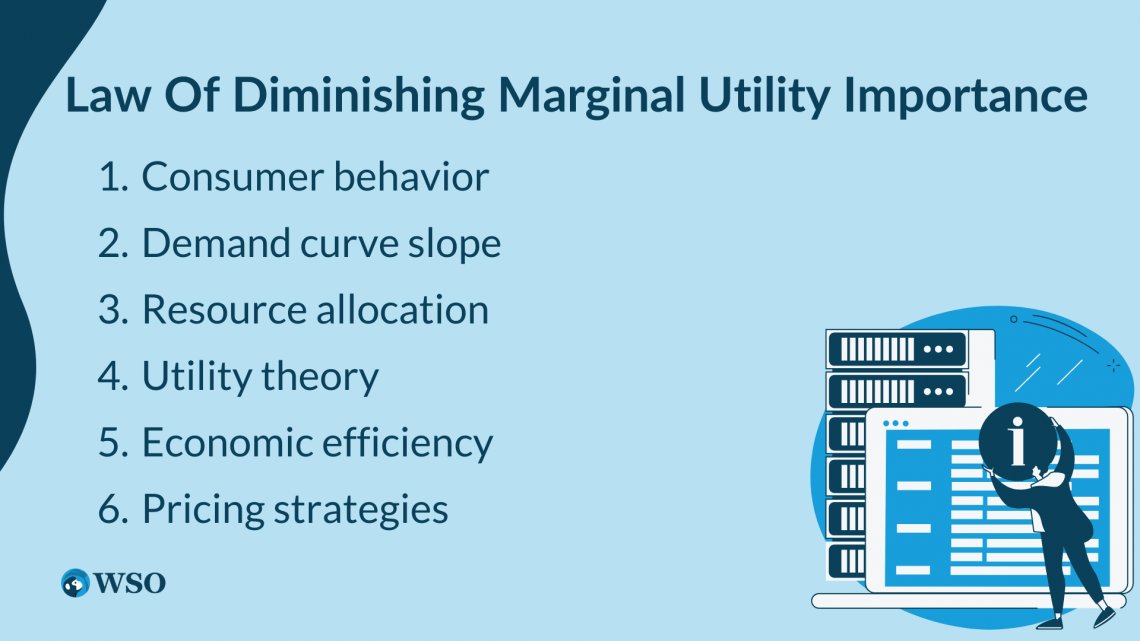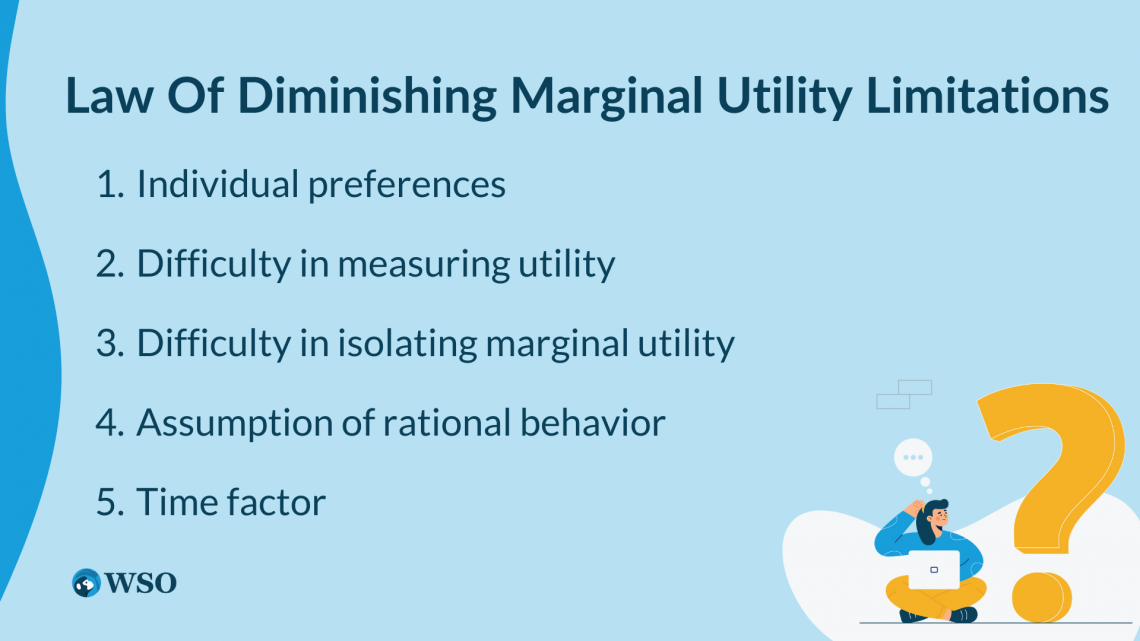Law of Diminishing Marginal Utility
This law helps explain consumer behavior and choices.
The Law of Diminishing Marginal Utility (DMU) is an economic principle that states as someone consumes increasingly more units of a specific good or service, the additional satisfaction or utility derived from every extra unit diminishes.

In other words, the extra you get of something, the less value or satisfaction you derive from acquiring extra of it. The concept is based on the statement that human wants and desires are finite and people have a constrained ability to benefit from consuming items or services.
When a person initially acquires a good or service, the first unit provides the highest level of satisfaction because it fulfills a specific need or desire. However, as additional units are consumed, each unit's satisfaction level decreases.
For example, consider a thirsty person. The first glass of water they drink will quench their thirst and significantly increase satisfaction. As they continue to drink more glasses, the level of satisfaction they derive from each additional glass will gradually decrease.
Sooner or later, they'll reach a point where they do not feel thirsty or derive any extra satisfaction from consuming excess water.

The law of diminishing marginal utility has vital implications for consumer behavior and economic decision-making. It helps explain why individuals make choices and allocate their resources in a certain way.
Consumers tend to allocate their resources to goods and services that provide the highest marginal utility or the most additional satisfaction per consumption unit.
From a business perspective, the law of diminishing marginal utility can inform pricing strategies. Companies understand that consumers are normally willing to pay greater for the primary unit of a service or product, as it provides the highest stage of satisfaction.
However, as consumers acquire more units, the marginal utility decreases, leading to a lower willingness to pay. Businesses often adjust their prices accordingly to maximize their revenue.

It helps understand how individuals make choices primarily based on the satisfaction they derive from consuming goods and services and how that satisfaction diminishes as they consume extra.
For example, imagine you're hungry and have a plate of your preferred food in front of you. Your first bite will likely provide a high level of satisfaction and fulfill your hunger.
However, as you continue to eat, each subsequent bite will provide less and less satisfaction. Ultimately, you could reach a point where you are full and find it difficult to consume another bite.
Key Takeaways
- The law of diminishing marginal utility states that as a person consumes more units of a specific good or service, the additional satisfaction or utility derived from each additional unit decreases.
- This concept assumes that individuals have rational preferences and make decisions based on maximizing their overall utility or satisfaction.
- This law helps explain consumer behavior and choices, such as why people tend to buy smaller quantities of a good as the price increases or why they seek variety in consumption.
- While the law is generally applicable, there can be exceptions or situations where it may not hold true.
- Understanding this law allows economists, businesses, and policymakers to make informed choices concerning resource allocation, pricing, and consumer behavior.
- It provides insights into how individuals derive satisfaction from consumption and helps explain certain patterns and choices observed in the market.
Diminishing Marginal Utility Assumptions
The Law of DMU is based on several assumptions. Here are the key assumptions associated with this economic principle:

1. Rational behavior
The law assumes that individuals are rational and make decisions based on maximizing their satisfaction or utility.
2. Cardinal utility
The law assumes that utility can be measured and quantified in cardinal terms. This means that individuals can assign numerical values to the level of utility they derive from consuming goods or services.
3. Diminishing marginal utility
The core assumption of the law is that the marginal utility derived from the extra unit of a good reduces with extra consumption per unit, holding other factors constant.
NOTE
In simpler terms, the law states that the more you consume something, the less additional satisfaction or utility you will derive from each additional unit.
4. Ceteris paribus
The law assumes that all other factors remain constant or unchanged. It focuses on the impact of increasing the quantity consumed of a particular good while assuming that factors such as income, prices of other goods, and consumer preferences remain unchanged.
5. Independence of units
The law assumes that the utility derived from each unit is independent of other units consumed. In other words, the satisfaction or utility obtained from consuming one unit of a good is not influenced by the consumption of other units.
6. Homogeneity
The law assumes that all the units consumed of a commodity are homogeneous or identical in size, shape, color, taste, etc.
NOTE
The law of Diminishing Marginal utility is an extensively everyday principle in economics and depends on these assumptions, which may not always hold true in real-world situations.
Law of Diminishing Marginal Utility Exceptions
While the Law of DMU generally holds true in many situations, there are some exceptions or cases where it may not apply or be less pronounced. Here are a few exceptions to consider:

1. Veblen goods
Veblen goods are luxury goods or status symbols whose demand increases as prices rise. In the case of Veblen goods, the higher the price, the higher the perceived status or prestige associated with owning them.
As a result, the marginal utility may not diminish with increased consumption but rather increase due to the social status or exclusivity associated with the goods.
2. Giffen goods
Giffen goods are inferior goods with a peculiar relationship between price and demand. In certain circumstances, when the price of a Giffen good rises, the demand for it also increases.
NOTE
Giffen goods contradicts the Law of Demand and implies that the marginal utility of the good may not diminish with increased price and consumption.
3. Collector's items
Certain items, such as rare coins, stamps, or artwork, may have increasing marginal utility for collectors. As the collection grows, each additional item may increase the overall value and satisfaction derived from the collection, leading to a potential increase in marginal utility.
4. Habit-forming goods
Some goods or substances, such as addictive drugs, can lead to a situation where the marginal utility does not diminish with increased consumption. Instead, the addiction or habit-forming nature of the goods may result in a continuous increase in demand and utility.
5. Emotional or experiential goods
Certain goods or experiences, such as memorable vacations, concerts, or sentimental items, may defy the Law of DMU. The emotional or experiential value of these goods can be subjective and may increase with additional consumption or exposure.
NOTE
These exceptions do not negate the general applicability of the Law of DMU. Rather, they highlight specific cases where the principle may not fully hold.
Law of Diminishing Marginal Utility Importance
The Law of DMU holds significant importance in economics and has several implications. Here are some reasons why the law is considered important:

1. Consumer behavior
The Law of DMU helps explain consumer behavior and decision-making. It suggests that as individuals consume more of a very good or service, the additional satisfaction or utility derived from each extra unit tends to decrease.
This understanding of diminishing marginal utility helps economists analyze how consumers allocate their resources and make choices about consumption.
2. Demand curve slope
The Law of DMU is closely related to the downward-sloping demand curve. The diminishing marginal utility concept implies that individuals are willing to pay much less for every additional unit of a very good, leading to a decrease in demand as prices increase.
NOTE
This relationship between diminishing marginal utility and the demand curve is fundamental in understanding market dynamics and pricing strategies.
3. Resource allocation
The Law of DMU provides insights into the optimal allocation of resources. It suggests that allocating resources to fulfill the most urgent needs or desires first maximizes overall satisfaction or utility.
NOTE
By understanding diminishing marginal utility, policymakers and businesses can prioritize resource allocation and make informed decisions about production, distribution, and pricing.
This law is a key component of utility theory, which forms the basis for analyzing consumer choices and welfare economics.
Utility theory helps economists model and predict consumer behavior and evaluate the impact of policy changes on social welfare. It provides a framework for understanding individuals' trade-offs when faced with limited resources.
5. Economic efficiency
The Law of DMU contributes to the understanding of economic efficiency. It suggests that resources should be allocated to maximize overall utility or satisfaction.
NOTE
Economic efficiency can be achieved by producing goods and services until the marginal utility equals the marginal cost. This principle guides resource allocation and production decisions in microeconomic and macroeconomic contexts.
6. Pricing strategies
This law is relevant for businesses when determining pricing strategies. It suggests that as consumers consume more of a good, the additional satisfaction they derive decreases.
This understanding helps businesses set prices that reflect the diminishing value consumers place on additional units, which can influence demand and revenue generation.
The Law of DMU provides insights into consumer behavior, resource allocation, demand, pricing, and economic efficiency. It is a fundamental economic concept that helps economists and policymakers make informed decisions and analyze various economic phenomena.
Law of Diminishing Marginal Utility Limitations
While the Law of DMU is a widely accepted economic principle, it does have certain limitations. Here are a few limitations to consider:

1. Individual preferences
This law assumes that individuals have consistent and predictable preferences. However, selections can be subjective and may range from person to person.
What one person considers as diminishing marginal utility, another person may not. People's preferences can also change over time, making it challenging to generalize the law across all individuals.
2. Difficulty in measuring utility
Utility is the satisfaction or happiness derived from consuming a good or service. Utility is a subjective idea that varies from person to person and is difficult to measure objectively.
NOTE
Since utility cannot be directly measured, it is challenging to accurately quantify and compare marginal utility across different individuals and situations.
3. Difficulty in isolating marginal utility
The Law of DMU focuses on the marginal more of a very good or service; the additional satisfaction or utility derived from each more unit has a tendency to decrease.
However, isolating the marginal utility of a specific unit can be challenging in practice. It is difficult to separate the satisfaction derived from one unit from the overall satisfaction or utility derived from the total consumption of a good.
4. Assumption of rational behavior
This law assumes that individuals behave rationally and make decisions to maximize utility.
However, people might not always act rationally because of different factors, including emotions, biases, social pressures, or incomplete data.
NOTE
These deviations from rational conduct can impact the law's applicability in real-world situations.
5. Time factor
The Law of DMU assumes that the consumption of goods occurs within a short time frame. However, in reality, consumption patterns may vary over longer periods.
For example, the utility derived from consuming a good in the short term may be different from the utility derived over a longer period. The law may not accurately capture the dynamic nature of utility over time.
It's important to recognize these limitations when applying the Law of DMU and consider the specific context and factors influencing individual preferences and behavior.
Conclusion
The law of DMU is an essential concept in economics that focuses on the relationship between the consumption of a good or service and its satisfaction.

The law of DMU is based on several underlying assumptions. Firstly, it assumes that the consumer's preferences remain unchanged throughout the consumption process. Secondly, it assumes that the units of the goods or services consumed are identical and of the same quality.
Lastly, it assumes that no other factors influence the consumer's utility or satisfaction apart from the consumption of the good or service.
The law of DMU has significant implications for consumer behavior and decision-making. As the marginal utility of goods decreases, consumers are less willing to pay a high price for additional units.
Furthermore, the law of DMU also has implications for production and resource allocation. It suggests that the marginal productivity of resources used to produce a good or service will diminish as more units are produced.

Understanding this principle can help individuals and businesses make more informed choices regarding consumption and production.
The law states that as an individual consumes more units of a particular good, the additional satisfaction or utility gained from each additional unit diminishes.
This principle is based on the idea of rational purchaser behavior and serves as a key component in the know-how of consumer preferences, demand, and decision-making. While the law generally holds true, certain cases can have exceptions and limitations.
Nonetheless, the law of DMU remains a valuable tool for analyzing consumer behavior, pricing strategies, and resource allocation in various industries.
Law Of Diminishing Marginal Utility FAQ

The assumptions of the Law of DMU include rational behavior by consumers, a fixed level of income and wealth, a given period, no change in consumer preferences, and a single commodity under consideration.
Yes, there are exceptions to the Law of DMU. Certain goods, such as addictive substances, may not follow the law due to their unique consumption characteristics. Additionally, some goods may exhibit increasing marginal utility under certain circumstances.
The limitations of the Law of DMU include the assumption of rational behavior, which may not always hold true in real-world situations. Additionally, the law does not account for individual differences in choices, the influence of advertising and marketing, and the impact of income and substitution effects.
The Law of DMU is important because it helps explain consumer behavior, influences the shape of demand curves, guides resource allocation decisions, forms the basis of utility theory, and provides insights into economic efficiency and pricing strategies.
The Law of DMU is related to the downward-sloping demand curve. As the price of a good increases, consumers are willing to purchase fewer units due to the diminishing satisfaction they derive from each additional unit consumed.
Yes, the Law of DMU can be applied to non-material goods or services. Although utility derived from non-material goods is not directly measurable, diminishing satisfaction still applies as individuals consume more of such goods or services.
The Law of DMU guides pricing strategies by suggesting that consumers are willing to pay less for each additional unit of a good or service. Businesses can consider this principle when setting prices to reflect consumers' diminishing value on additional units, which can affect demand and revenue generation.
The Law of DMU is a general principle that applies to many consumption situations. However, variations and exceptions can be based on the characteristics of goods, individual choices, and other factors.




or Want to Sign up with your social account?